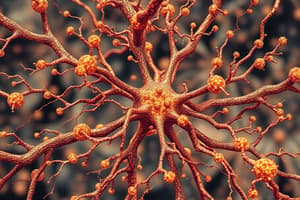Podcast
Questions and Answers
Describe the structure of a synapse.
Describe the structure of a synapse.
Presynaptic neurone releases neurotransmitter; synaptic vesicles store neurotransmitters; synaptic knob with mitochondria and endoplasmic reticulum; synaptic cleft between presynaptic knob and postsynaptic neuron; postsynaptic neuron contains protein receptors.
Describe the features of synapses.
Describe the features of synapses.
Unidirectionality and summation. Unidirectionality means information passes from presynaptic to postsynaptic neurone. Summation includes spatial and temporal.
Explain how inhibitory synapses operate.
Explain how inhibitory synapses operate.
Presynaptic neurone releases neurotransmitter that opens chloride ion channels; chloride ions enter and potassium ions exit the postsynaptic neurone, hyperpolarizing the membrane.
Describe the function of a synapse.
Describe the function of a synapse.
Flashcards are hidden until you start studying
Study Notes
Structure of Synapses
- Presynaptic Neurone: Responsible for releasing neurotransmitters.
- Synaptic Vesicles: Storage units for neurotransmitters within the presynaptic neurone.
- Synaptic Knob: A bulging area at the terminal end of the presynaptic axon; rich in mitochondria and endoplasmic reticulum.
- Synaptic Cleft: The small gap between the presynaptic knob and the postsynaptic neurone's membrane.
- Postsynaptic Neurone: Contains receptors that specifically bind to the neurotransmitters released from the presynaptic neurone.
Features of Synapses
- Unidirectionality: Information transfer only occurs from presynaptic to postsynaptic neurones, ensuring a one-way flow of signals.
- Summation: The process in which neurotransmitters accumulate in the synapse.
- Spatial Summation: Multiple presynaptic neurones release enough neurotransmitter collectively to trigger an action potential in the postsynaptic neurone.
- Temporal Summation: A single presynaptic neurone repeatedly releases neurotransmitter in a short time frame, potentially exceeding the threshold to initiate an action potential.
Inhibitory Synapses Operation
- Release neurotransmitters that bind to chloride ion channels in the postsynaptic neurone.
- Chloride channels open, allowing chloride ions to enter the postsynaptic neurone via facilitated diffusion.
- Activation of nearby potassium channels allows potassium ions to exit the postsynaptic neurone.
- Influx of negatively charged chloride ions coupled with efflux of positively charged potassium ions makes the inside of the postsynaptic membrane more negative.
- Membrane potential can drop to -80mV from a usual -65mV, leading to hyperpolarization.
- Hyperpolarization decreases the likelihood of generating a new action potential due to the increased sodium influx required.
Function of Synapses
- Synapses facilitate communication between neurones by:
- Allowing an impulse in one neurone to trigger multiple impulses in various neurones, resulting in simultaneous responses from a single stimulus.
- Integrating impulses from multiple sources, enabling varied reactions to different stimuli to converge into a unified response.
Studying That Suits You
Use AI to generate personalized quizzes and flashcards to suit your learning preferences.





